‘Kipo and the Age of Wonderbeasts’ Creators on Their Stylish New Netflix Series
After spending her entire life living in an underground burrow, a young girl named Kipo (Karen Fukuhara) is thrust into an adventure on the surface of a fantastical post-apocalyptic Earth. She joins a ragtag group of survivors as they embark on a journey through a vibrant wonderland where everything trying to kill them is downright adorable. The series is created and executive produced by Rad Sechrist (How to Train Your Dragon 2) and executive produced and developed for television by Bill Wolkoff (The Man Who Fell To Earth). We had a chance to chat with both of them to see how Kipo and the Age of Wonderbeasts came to be.
The cast features Karen Fukuhara (She-Ra and the Princesses of Power) as the enthusiastic and curious “Kipo;” Sydney Mikayla (General Hospital) as “Wolf,” a weapon-wielding survivor who knows the ins and outs of the surface; Coy Stewart (The Blacklist) as the happy-go-lucky “Benson;” Deon Cole (black-ish) as “Dave,” a talking insect who has the jarring ability to suddenly age a full life cycle without warning; and Dee Bradley Baker (Star Wars: The Clone Wars) as the adorable mutant pig “Mandu”.
The series includes the voice talents of Sterling K. Brown (Frozen 2) as Kipo’s father “Lio Oak;” Dan Stevens (Legion) as the power-hungry “Scarlemagne;” Lea Delaria (Orange is the New Black) as Timbercat “Molly Yarnchopper;” Joan Jett as rocker snake “Camille;” and John Hodgman and GZA (Wu Tang Clan) as the cosmically-curious wolves “Billions and Billions.” Kipo and the Age of Wonderbeasts presents a unique animation style alongside edge-of-your-seat storytelling that will entice viewers of all ages, and it’s streaming now! Be sure to check out my review here.
See what Sechrist and Wolkoff had to say about Kipo below:
Rad, for people out there who might not be familiar with your comic that originally started everything, could you talk a little bit about its history and give a general idea of what it’s about?
Rad Sechrist: Yeah, so I had been drawing comics for years. I actually drew comics before I got into animation and I was always just kind of doing them on the side or at night. I was really inspired by shows like Walking Dead and Game of Thrones and I just wanted to do a big epic kind of end of the world narrative. And, in fact, in my mind I was thinking I was going to make it dark and gritty and kind of adult. And as I started drawing it think it kind of came out fun. And at one point I went, “You know, I actually just to lean in to my natural sensibility and just keep it fun and not so adult and gritty.”
So how did Kipo go from that web comic into development as an animated TV series?
Sechrist: I think one of the executives has seen the comic and was interested in it. It’s funny because I think Peter Gallo at one point told me like, “If you would’ve told me you’re going to pitch me apocalypse show, I would have told you don’t even bother. But somehow you manage to make this pretty fun.” And then he kind of introduced me to Bill.
Bill Wolkoff: Yeah. One of the DreamWorks executives sent me Rad’s web comics, which I fell in love with the story and the idea of the world and also Rad’s unique and fantastic drawing style and we are sort of in a kind of a work date and I told Rad my ideas about how I would expand it into a TV show. For me it would leaning into, preserving the post-apocalyptic side of it and making those stakes very real and leaning into the fantastic element, the whimsical element that was in the DNA of Rad’s web comic. I always described the show, I’ve said this to Rad many times, it’s Walking Dead meets Alice in Wonderland.
Kipo is a symbol of hope in this world, in a world where you might not … many people wouldn’t have hope and wouldn’t be optimistic. She is able to keep the wonder in that world and that’s one of the things, how we wanted to expand it into a TV show and Rad was like, all right, let’s go out. We started “work dating” and had many, many, many, conversations as we built out the world, wrote scripts. Rad drew many, many more designs. And then sold it to Netflix, happily.
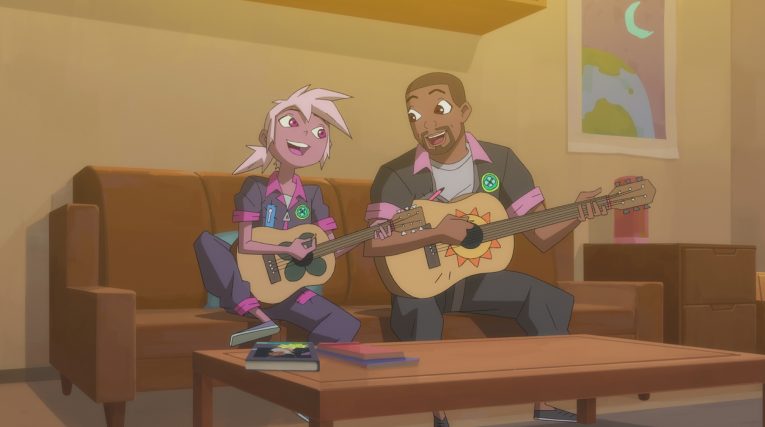
Image via DreamWorks TV, Netflix
What was your process like in expanding the story? Did you have to make any major changes? Did you take it in a direction that the comic wasn’t going?
Sechrist: I think the comic was very, very kind of a simple plot. It was a girl from an underground city that kind of grew up with a life that’s kind of like our life. She’s never dealt with these giant monsters. She gets thrown into the world. And I kind of was treating it pretty simple. You walk along, you meet this group of people and you have a little story and then you walk along and you meet this group of people and you have a little story. More like a long running comic way of thinking. And when I met with Bill, he kind of just expanded it almost, put some nitrous oxide in there.
Wolkoff: It is a world that exists beyond the borders of the web comic. As we got into it, there were these core two characters that were in the Rad comics: Kipo and Wolf. And they did evolve a little bit as we expanded it out. But the concept of this world that had a great big outbreak and animal mutated out of control and some animals are human-sized and have sentience and have adapted different cultures from the old world and occupied these lands that obviously the vegetation has grown over.
It’s not a world that has one particular government. It’s kind of, this strange old world and that’s just an amazing deep world to set a show in because you can see how they’d have to travel to these long distant lands. And there’s also something very powerful about creating an end of the world story, in a hopeful, optimistic way. And I think it grounds emotionally. I think it regulates emotionally where we are today a little bit. Sometimes it feels like the world is ending. And if I was a kid, I think it would help comfort me seeing an empowering story of kids rushing to this world and overcoming it and finding, being hope and wonder in it. And that was a big driving force on how we expanded it out. also, it is a great world that allows us to tap into the playful side of our personality, and how we came up with the different animal characters that occupy different areas. Sometimes Rad would just draw something.

Image via DreamWorks TV, Netflix
When the idea of a mutant wolves came, that came from one of Rad’s drawings of a wolf wearing a Carl Sagan-esque turtleneck and a blazer. We just filled in that backstory. “Oh! They must have found the Griffith Park Observatory and they must have found a picture of Carl Sagan and adopted that culture.” And we were able to develop a full story based on that and that kind of came from many different ways and it was just so fun. We got to play in that sand box.
It was just Rad and I developing the first couple of episodes, but once we got an official green light for the series, we had this great creative team, a creative writing team and we had great directors and board artists. Everybody had ownership. We ran the writers room, by the way, like we would run a live-action room.
Can you talk about taking your designs, translating them to the screen, and also working with Studio Mir for your world design, your character designs, and the look of Kipo?
Sechrist: Yeah, it’s interesting because at first a lot of people were coming to us and being like, I don’t think you can animate that style. You should change it. And at one point I think we even did a test where it looks more classic, like a lot of anime, you know?
And luckily for us, I think Peter Gal literally walked into my office one day and pointed to a poster on the wall that we had drawn during development. And he said, ‘I don’t care what it looks like, just make it look exactly like that.’ We went back to the animators and I think at one point we were like, “Look, I know it looks a little weird. Could you just try to animate it?” And so they’re a little hesitant and they did it and it came back looking awesome. And I think one of them was like, ‘Oh yeah, it wasn’t actually that hard.’
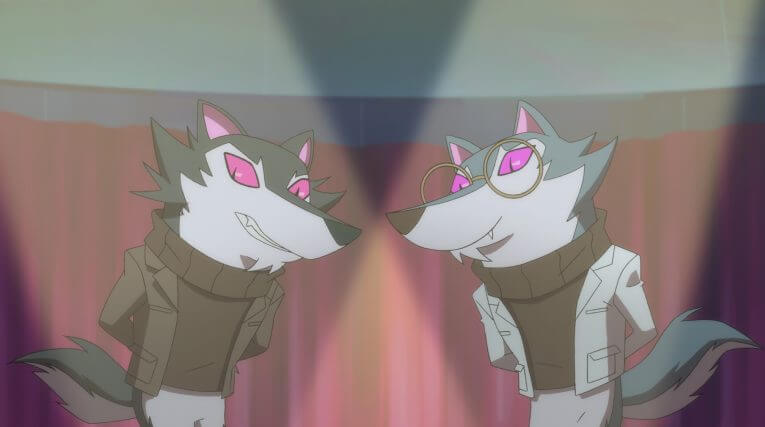
Image via DreamWorks TV, Netflix
There was a definite hesitance to try it at first because it looked like it was just going to be hard. The eyes get cut off weirdly like halfway off the face and there’s a lot of things that appear, ‘Oh, that’s how that going to move.’
Wolkoff: I’d like to give a big hats off to Studio Mir for making, for taking Rad’s style and finding ways to make it animatable. Because we haven’t seen a show that looks like this style before. I mean, the big lesson for me coming into this role is seeing that challenge and seeing the studio rise to that challenge. It took work and they deserve a lot of credit for that. I know that after working with Angela Sung, our art director, who would provide many expression sheets and acting… We had great character designers who would do key poses that helped them, give them some of the tools to be able to be turn it into an animatable style that you could do on a TV production schedule. I mean for me it was just beyond my expectations, which I think they really knocked it out of the park.
Yeah, I agree.
Sechrist: Yeah. I pinched myself, like I can’t believe we got to work with Studio Mir. Like I mean they’re probably the best in the kind of the Western markets. They’re incredible.
That’s awesome. They did a fantastic job and it was cool to see your initial designs keep their spirit. You can recognize your work in the finished product, but you can see their hand in the animation as well. And it worked really, really well.
Sechrist: It was amazing to visit, too. They’re drawing it on paper and scanning it in.
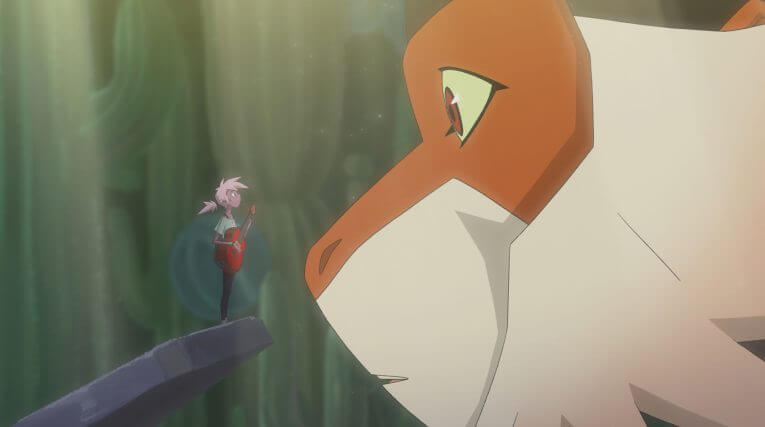
Image via DreamWorks TV, Netflix
Yeah, crazy. It’s cool too for like an old animation head like me, it’s cool that people are still doing that today. It’s kind of mind-blowing.
Sechrist: It’s so amazing
I definitely want to talk about the music of Kipo as well cause that’s another standout. So how did you go about finding the right sound for the show?
Sechrist: Well, when me and Bill were doing the pilot, which we kind of were just putting in songs we like and so I’m into a lot of hip hop and indie rock and we’re just kind of putting in stuff, like watching skate videos growing up. And I honestly thought DreamWorks was going to watch that and be like, this is great. But yeah, we already have to take all that music out. But instead, we were in the meetings and they were kind of bobbing their head, like, ‘That’s really cool!’ And so we worked with Kier Lehman as our music supervisor and James Cartwright. And then we found our composer, Daniel Rojas, and they were into the same kind of stuff, which was really awesome. The first time they met Kier, we were both kind of geeking out about similar types of music. And he was just finishing up Spider-Verse I think.
Sechrist: So yeah, every time they would send songs, I was like, dang, this is even better than the one we’d put in.
Wolkoff: You might notice that a lot of the backgrounds in this world are inspired by the East Side of Los Angeles. Rad is from Highland Park. I live in Atwater Village and there’s a style to our side of town. Rad and I have a lot of musical tastes that overlap. And since this is a show that’s very much about that world 200 years in the future, we wanted it to sound like that world, too. We realized it was a real opportunity to have a unique musical tapestry. And we’re so lucky that DreamWorks backed us up on it. And Netflix, too. They were very excited about that. And this incredible musical team that they brought to us to realize that it’s… music was such a part of this in our lives and also the old world that … it felt like it had to be a part of Kipo. We wanted to make it a musical that’s not a musical, not where people are just breaking out into song, but when, when they do sing it’s natural to the world and organic to the world, which is reflective of our world.
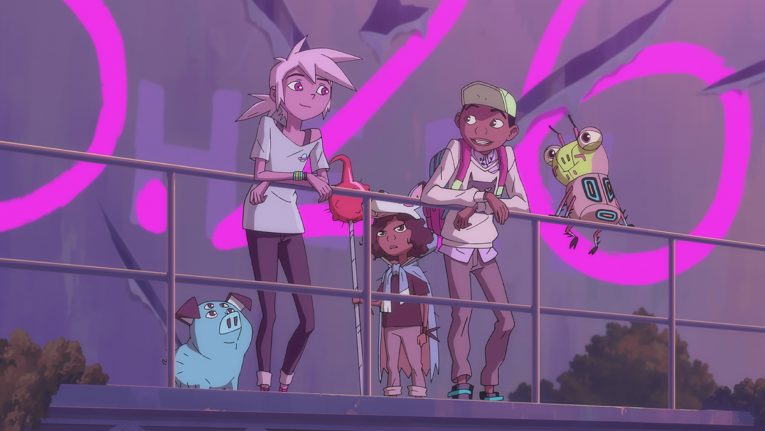
Image via DreamWorks TV, Netflix
You guys have assembled quite the cast here. For me, the two that stand out are your lead Karen Fukuhara, but also Dan Stevens as Scarlemagne, who I did not expect to be so incredible and intimidating and kind of crazy as this main villain. What was it like seeing these characters come to life and get kind of this reinvigoration of energy as voiced by your cast?
Sechrist: Yeah, I mean, I’ll start with Kipo a little bit. It was such a pleasure to work with Karen and go into those records. Her personality just coming through… She added so much to that character that we all just loved. As we started to cut her voice into those animatics, it just really came alive and in my mind, Bill is the father of Scarlemagne.
Wolkoff: We approached Dan Stevens with a very specific vision for the character and he ran with it. We talked about being equal parts Amadeus, the Tom Hulce Amadeus.
Wolkoff: And the joker. Just as a springboard for Dan to dive off of, rooted in a very real, emotional pathos, somebody who feels like, you know, that the old world has slighted them and you have a real grudge against humanity. How to make that feel real while at the same time it could be performed and filmed, but also scary. Personally I, when I was a kid, I loved the characters that scared the pants off of me.That was a big goal. Even I was scared by Dan in the booth, and he’s a very sweet guy.
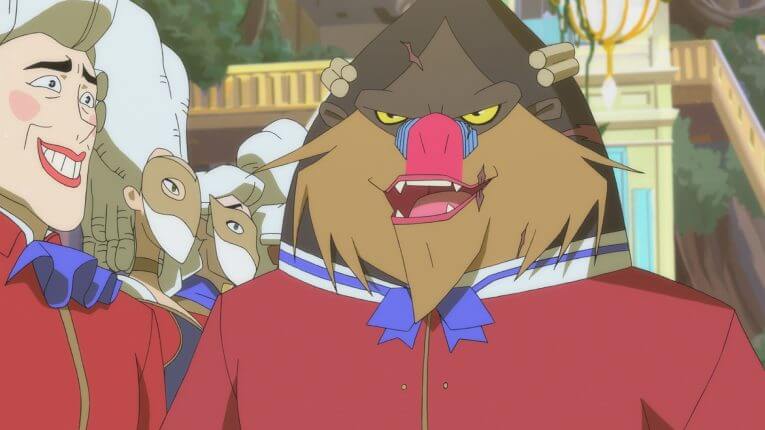
Image via DreamWorks TV, Netflix
Honestly it’s funny that you mentioned the Joker being as sort of like a spiritual inspiration for it because as I was listening to him, especially when he got into some of his maniacal laughter, I was like, I would like to see Dan Stevens play an animated Joker. So that’s actually really funny that he specifically called that out because I want to hear that.
I’m sure you can’t get into specifics about episode order or season order, but season one kind of ends on a bit of a cliffhanger. We get a good resolution, but there’s definitely more to the story. So what could you tease about the events of a possible season two if we were to see that?
Sechrist: I think I’ve been told you have to stay tuned!
That’s a good one.
Sechrist: My direct orders from DreamWorks.
Fair enough. We can leave it at that.
Wolkoff: I reiterate that.
Wolkoff: The moon boy is looking down at us right now and saying, “Shhh! Don’t say anything!”

Image via DreamWorks TV, Netflix
Exactly. Is there anything else that the two of you are currently working on that you can talk about or is Kipo pretty much taking up all of your time at the moment?
Sechrist: I’m in development at DreamWorks features, but it has nothing to do with Kipo.
Wolkoff: Kipo is a big part of my life. I’m also working on a TV show for CBS All Access that’s a lot of fun. It’s not animated, it’s not a kid’s show, but I think we’re coming up with some pretty cool stuff.
I’m definitely looking forward to seeing more of Kipo. Thanks for chatting with me today and I can’t wait for people to check this out. And then hopefully we get to talk again when season two rolls around. So thanks again.

BY DAVE TRUMBORE/Collider

熱門頭條新聞
- Healing Anime Recommended
- Final Fantasy XIV May Come to Nintendo Switch 2
- ASEAN Digital Content Summit 2025 Opens on September 2
- INDIE GAMES PLATFORM HYTOPIA DOUBLES CREATOR FUND TO $250,000, WELCOMES TWO NEW PARTNER STUDIOS
- Tag Team Action-RPG Goddess Order Launches Globally This September!
- China’s Entertainment and Media Industry Ushers in a New Cycle of High-Quality Development
- Sony PS5 Global Sales Closing in on GBA’s Historic Record
- Infinite Nikki announced that it will start a dream collaboration with Stardew Valley this month.
